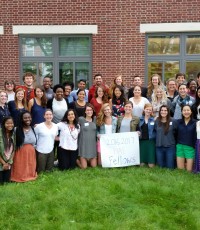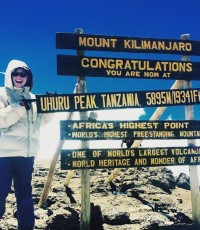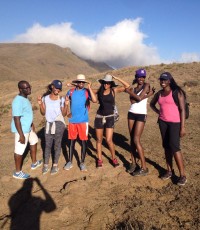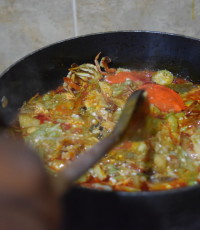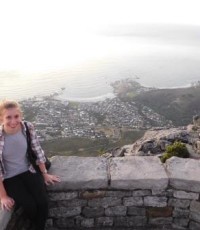May - June 2016
Dear Friends,
It’s official: we’ve placed our newest 2016-17 fellowship class! Check out the Current Fellows page of our website to learn about this year’s 49 Fellows, who will be working with 31 organizations in 15 countries across the African continent.
In late May, we enjoyed connecting with PiAf friends old and new (including board members, alumni, and new Fellows and their family members) during Princeton’s annual Reunions weekend. The following weekend, we welcomed our 2016-17 Fellows at their orientation on Princeton’s campus. You can see more photos of PiAf’s Reunions events and Fellows’ Orientation on our Facebook page.
This month’s Fellows Flyer includes a Supporter Profile of Daniela Kaisth of Gratias Partners. Daniela is a longtime PiAf board member who has provided invaluable support to our organization over the years. Many thanks as always to Daniela and all those who make our remarkable fellowship program possible.
We hope you enjoy this edition of the Fellows Flyer!
Warm regards,
Jodianna Ringel
Executive Director
P.S. Our 2016 newsletter is here! View it on our website to read articles written by our Fellows, updates on where our alumni are now, and news about all things PiAf.
PiAf Connections
Please click below to check out pictures of our Fellows, Alums and other members of the PiAf family meeting up at home and around Africa.
Notes from the Field
By Nafees Ahmed, 2015-16 Fellow with Village Enterprise in Kenya/Uganda
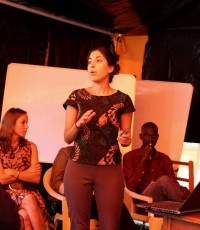
Nafees (center) explaining the new visual business plan template at the annual Village Enterprise Innovation Summit.
During the course of this year, I’ve been asking some interesting questions: “What is the value of a business plan?” “Does it encourage long-term planning?” “How can business owners create a business plan if they cannot read or write?”
Village Enterprise works with the very bottom of the pyramid (VBOP) to create sustainable businesses. We believe in the importance of our business owners to think ahead and plan for the coming year’s business activities. Still, 33% of the business owners we work with cannot read and 31% cannot write.
In response to this, the Village Enterprise field team launched a pilot called the Visual Business Plan. It was termed “visual” because business owners had the opportunity to draw out their business plan. We hoped that drawing would circumvent the literacy hurdle. But, who ever said drawing was easier than writing?
Thanks to Village Enterprise’s inclusive structure, feedback from the field boomerangs back to the office fast. Business owners told us that they could not draw their business plan. Others still drew their plan but months later had difficulty interpreting it. I analyzed the visual business plans on our data platform, Salesforce, and confirmed these complaints.
The response to these implementation challenges exemplifies one of Village Enterprise’s top qualities: we are agile. Our team is constantly learning from the field and adapting quickly. The participants in our program are not just beneficiaries, they are our clients and we shape our program based on their needs.
So this year, I decided to take on the responsibility of revamping our approach. I developed templates for our business plans: one for agribusiness, one for livestock businesses, and one for retail and service businesses. These templates include pre-drawn images for all possible activities that business groups can partake in – that my artistic niece volunteered to draw! The images include finding a business location, purchasing supplies, hiring employees, conducting market and competitor research, diversifying the business, marketing to new customers, and saving money.
During the Visual Business Planning training business owners will be asked to circle the images that they will participate in – much easier than drawing the image themselves. They will also record which business activities correspond to which time of the year. They will save their Visual Business Plan in their record books and refer back to it during business group meetings.
The visual business plan is currently in the field being tested on business owners. There are still many questions I have: “Will our business owners understand the images?” “Will they refer back to the plan throughout the course of the year?” “Will the plan help them prepare for the year’s business activities ahead?”
As it’s piloted in the next month, we will monitor the business owners to get feedback on some of these questions. I’m really looking forward to seeing our visual plans come to life.
Notes from the Field
By Melissa Barber, 2015-16 Fellow with Clinton Health Access Initiative in South Africa
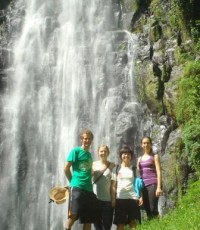
Melissa (second from the left) with fellow Fellows David Lunde, Cameron Yi, and Mariah Wood during a waterfall excursion at the 2016 Fellows’ Retreat in Moshi, Tanzania.
Tuberculosis (TB) has now surpassed HIV as the leading cause of death from infectious disease worldwide. TB is the leading cause of death in South Africa, where 450,000 people developed active TB in 2013 – nearly 1% of the population. The epidemic is disproportionately borne by communities in poverty, mine worker communities, and people living with HIV— an estimated 70% of people with tuberculosis in South Africa are also HIV positive. The treatment for tuberculosis is long — at least six months — but efficacious and relatively nontoxic. In contrast, the treatment for multi-drug resistant tuberculosis (MDR-TB) or extensively drug resistant tuberculosis (XDR-TB) takes two years and requires painful injections. Common side effects include nausea, deafness, depression, and psychosis. While the cure rate in normal TB is 80%, for MDR and XDR TB cure rates are only 40% and 20%, respectively. In one study of 53 patients in one hospital in Tugela Ferry, in the KwaZulu-Natal province, only a single patient survived.
Despite significant mortality, tuberculosis research and development remains chronically underfunded. Bedaquiline and delamanid, the first new medicines in half a century, have received interim WHO approval and are significantly more effective and less toxic than existing treatments for multi-drug resistant tuberculosis, yet remain unavailable for most patients due to high prices, and, in the case of delamanid, unwillingness of the producer Otsuka to register the drug in high-burden countries in the two years since it received EMA approval. Linezolid, a drug initially used to treat leprosy, has compelling preliminary data supporting its use for XDR-TB. Pfizer holds a monopoly on linezolid sale in South Africa, and in the private sector a treatment course is priced at US$46,800. While the public sector has negotiated better prices, the drug remains unaffordable for widespread use and its use even in limited settings places a significant burden on the public medicines budget.
Coming from a civil society and international agency background, I have been grateful for the opportunity to learn more about the challenges faced by the government in introducing new medicines and procuring existing medicines within a constrained budget. The prices of medicines have skyrocketed worldwide, and regulatory efforts have not always been able to match the aggressive pursuit of early profit by pharmaceutical companies, and the political muscle of the high income countries that protect their interests. While South Africa might seem like a relatively small market, any local legal reform to lower prices and/or open the market to competition results in a well-funded global opposition. A series of leaks revealed that in 2014 the US lobbying group the Pharmaceutical Researchers and Manufacturers of America, or PhRMA, had paid $450,000 to a private consultancy to plan the undermining of South Africa’s intellectual property reform process.
Medicines procurement in South Africa is public, but supply is privately controlled and profit-focused: governments can regulate, but except in a few cases of public manufacturing, they must deal with an industry that can – and does – withdraw or refuse to supply lifesaving medicines. I am inspired daily and have learned so much from the brilliant and dedicated staff at the Affordable Medicines Directorate of the National Department of Health, with whom CHAI works to lower the price, protect the quality, and ensure the supply of medicines. As the current tuberculosis medicines situation attests, there is still a long road ahead in securing universal healthcare and equitable access to medicines.
Notes from the Field
By Katie Bernhard, 2015-16 Fellow with The Rwanda School Project in Rwanda
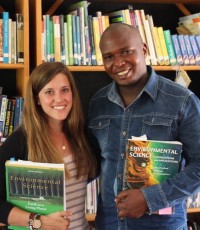
Katie (left) and Gilbert, the upper-secondary Geography teacher, in the library after an Environmental Science Program development meeting.
I usually meet with Gilbert, the upper-secondary Geography teacher at The Rwanda School Project, in our school’s small but well-stocked library. During the past ten months in Rwanda, I have been developing a first-of-its-kind Environmental Science Program for the school that will, hopefully, innovatively combine environmental education, including Advanced Placement (AP) Environmental Science, with elements of the Rwandan Ministry of Education system. A major part of the development of this program is working to transfer environmental science knowledge to Gilbert, so that he is prepared to become the permanent Environmental Science Program Director after my fellowship ends in July. Using two distinct environmental science textbooks, I have given Gilbert comparison readings, we have pinpointed which environmental textbooks work in the Rwandan context and why, and we have determined how environmental education can be slipped into our current Rwandan National Geography Curriculum.
One afternoon, as we discussed a particularly dense Environmental Science textbook chapter, Gilbert said, “This idea of environmental sustainability – this is new to me. I have been taught all my life in Rwanda that sustainability is economic sustainability, but this idea of ensuring that business and industry can protect the environment and our natural resources for future generations is new. This is important.”
Sustainability. Depending on a person’s background, education, or geographic location, this word implies myriad interpretations, meanings, and connotations. Given my own background in environmental science, I have a propensity to consistently use the environmental definition of sustainability. But throughout my Princeton in Africa fellowship, I have learned that other types of sustainability can be just as important. To use one small example, the Environmental Science Program will ultimately fail if I do not work to ensure its conceptual sustainability within the institution. Sustaining this program (and the conceptual foundation that I have laid for it) after I leave can be accomplished by continuing to work closely with Gilbert and the administration, transferring knowledge about environmental science and the goals of the program. But one year suddenly seems a very short time to meaningfully accomplish this task. It is a particularly short time to transfer sufficient knowledge to sustain an innovative program in a burgeoning field, like the environmental field in Rwanda.
So as I reflect on my fellowship (my, how the time has flown!), I think of the work I have done for The Rwanda School Project and I am at once filled with both accomplishment and urgency. I have had incredible opportunities here for exploration, for personal and professional development, and for adventure. But at The Rwanda School Project, there is so much left to do. And, for sustainability, there will always be so much left to do.
Notes from the Field
By Marlotte de Jong, 2015-16 Fellow with World Agroforestry Centre in Kenya
When I opened my email on a Monday morning to find that I had been offered a position with the World Agroforestry Centre in Nairobi, I knew that I was in for a year filled with ups and downs. I told myself that this year would be just like climbing a mountain – it would be tough at times but the journey would be worth it. Little did I know that I was about to climb the physical mountain as well as the metaphorical one.
I, along with 12 others, embarked on the exhilarating journey of climbing Mt. Kilimanjaro, the roof of Africa and the world’s highest freestanding mountain. Everything about climbing Kilimanjaro eerily reminded me of my PiAf year. From stressing about whether or not I had the right clothes and supplies with me to the odd combination of excitement and panic, the similarities between Kilimanjaro and my fellowship year were striking. But it wasn’t until I stepped foot on the mountain that I realized I was about to climb the physical manifestation of my yearlong fellowship journey. Just like how I pictured myself standing at the peak, I visualized myself at the conclusion of my fellowship year with amazing work and life experiences under my belt. And just like the feelings that consumed me before I left for Kenya, there was a little voice doubting whether it was possible.
Like my fellowship year, the first bit was easy. Everything was new and exciting. I felt confident that I would make it no problem – I was having the time of my life! But soon, as we climbed higher and the air got thinner, things weren’t so easy anymore. In my fellowship year, I struggled with homesickness, frustration about sexism that unfortunately exists in many parts of the world, and the horrible feeling of never being anonymous. It was at those times, both in climbing Kilimanjaro and my year in Nairobi, that I doubted whether it was possible. But in both things, it was the support of others that got me through. On Kilimanjaro, it was our all-star guides and the support of the amazing friends that climbed with me (special shout out to Melissa Gibson, my fellow PiAf Fellow, for feeding me Snickers and Gu when I was too exhausted to even move my arms). And it was the support of my family and friends in Nairobi and at home that allowed me to vent and reminded me that I could overcome these challenges.
Like Kilimanjaro, I would be lying if I said my fellowship year wasn’t hard at times. But, like my time on Kilimanjaro, there were far more moments where I can’t even describe how happy I was. My fellowship year was a journey, at times difficult and, more often, wonderful. As my fellowship year is coming to an end, I can clearly see myself “standing at the top” with a year’s worth of memories and the knowledge that, like Kilimanjaro, every difficult moment is what helped make it so worthwhile at the end.
Notes from the Field
By Joan Larbi, 2015-16 Fellow with African Leadership Academy in South Africa
Mosquitoes, Fish, and Like-minded Individuals
Accra – Junior accidentally launches a Christmas firecracker through the plastic mesh door screen. We gaze at each other silently, thinking of what to tell my mother when she returns because the melted netting has left a large hole for mosquitoes to enter the house.
Cape Coast – “After many days in the dungeons, the slaves that survived would finally be led to the ship through here, the ‘Door of no return,’” says the tour guide. I peer through the small opening in the Elmina Castle wall and see shirtless men on beached canoes, hauling in a net full of fish.
Kumasi – Time for bed. Earlier I got my hair done across the street from my Grandma’s house. Now my scalp feels taut, the weighty extensions flowing everywhere. Meanwhile, my sister reads comfortably on the bed, her braids held together by a hairnet.
Whether to keep mosquitoes out for malaria prevention, catch fish for food, or secure hair for sleep, my childhood vacations in Ghana taught me that nets work. My fellowship year in South Africa has shown me that networks do, too.
I confirmed this at the PiAf mid-year retreat when we stood in a circle sharing takeaways. After speaking, each Fellow would throw the yarn ball to another, holding onto the string, such that we literally created a web. As I waited my turn, I thought of my PiAf application, where I wrote: Princeton in Africa offers a network of like-minded individuals committed to Africa’s progress. During and beyond the fellowship, my peers and I would serve as sounding boards for each other’s ideas and keep one another accountable to our goals. Reading this now, it almost sounds prophetic because the meaningful connections I’ve made have shaped my fellowship experience.
In particular, I have found even more “like-minded individuals” outside of the immediate PiAf network. For example, through the African Young Professionals (AYP) group that I joined in Johannesburg, I have met a diverse group of incredible people. Whether it’s attending a Young African MBA (Y.A.M.) professional networking event or throwing an impromptu screening party to watch Beyoncé’s Lemonade video, I can count on this group of friends. Similarly, I have tapped into the University of Pennsylvania network, connecting with multiple Penn alumni while I’ve been here and even meeting a newly admitted student from Ghana. Finally, at African Leadership Academy (ALA) my colleagues and I bond with each other as we work to identify, develop, and connect the next generation of African leaders.
They say “It’s not what you know, but who you know” and some add “Especially in Africa.” But, I am confident that cultivating connections can create constructive change on this continent. More than ever, I believe that Africa needs to nurture networks, in every sense of the word: transport networks (think functional and cost-effective Pan-African roads, railways, and airline routes); telecommunication networks (think greater cellphone penetration and reliable internet connectivity); and transformational leadership networks (think once again, “like-minded individuals committed to Africa’s progress”).
Notes from the Field
By Akinyi Ochieng, 2015-16 Fellow with Global Shea Alliance in Ghana
While things like dress or language may separate different cultures, the one thing that unifies us all is the need to eat. Growing up, food was the unifying force that united my disparate identities: British, Gambian, Kenyan, and American. I think that what you cook is an accumulation of your experiences. When you share your food, you share a piece of your history – and a piece of yourself.
During my time in Ghana working at the Global Shea Alliance, food has been central to how I’ve learned about Ghanaian customs, and how I’ve connected with people. Learning about food is also a part of my job! As the GSA’s Communications Manager, part of my job is to raise awareness about shea. Most people know shea for its myriad cosmetics benefits, but across West Africa, 90% of shea is actually used in food. In my time at the GSA, I’ve learned the various ways that communities cook with shea. As the most common vegetable oil in Northern Ghana, it’s frequently used in soups and stews. On my first trip to Northern Ghana with the GSA, I discovered that the fresh green shea fruit can also be eaten raw as a sweet treat.
While living in Accra, I’ve been introduced to a wide variety of local dishes, which I’ve mastered with the help of my patient Ghanaian friends. I’d like to introduce you to a few:
Kelewele. The queen of Ghanaian street food snacks. Kelewele is delicious fried plantain seasoned with a variety of spices like ginger, hot pepper, and salt although some people add onions and cloves.
Red-red. Red-red is a traditional recipe of spicy black-eyed peas. The name comes from the red palm oil used to prepare the dish. It is often accompanied by kelewele, although if you’re rebellious like me, you can eat it with rice. Be careful—red-red can make your eyes water due to the Ghanaian penchant for pepper.
Banku and Okro Stew. If you think fufu is too heavy, you might want to try its lighter cousin banku, a fermented corn and cassava dough mix that is common among Ghana’s Ewe people. Banku is frequently accompanied by either tilapia (Ghana’s signature fish) or “okro” (okra) stew. You can find my full recipe here.
I’ve loved getting to learn about Ghana’s cuisine, and tasting the foods of the country’s over 40 different ethnic groups. By the end of my fellowship, I hope to have a few more classic Ghanaian recipes under my belt. My time as a Princeton in Africa Fellow has only increased my desire to explore and experience Africa’s rich cultural diversity.
Notes from the Field
By Anna Oltmann, 2015-16 Fellow with mothers2mothers in South Africa
When I asked my coworkers to remind me of a good story from my fellowship year worth sharing for my Fellows Flyer, they started laughing and providing suggestions. They suggested I talk about everything from the time I had to chase down the information I needed for a proposal, to the first time I presented at our weekly meetings, to when we went painting a few weeks ago as our department team-building activity.
The stories they were reminding me of were not groundbreaking. In fact, they are probably typical of office environments everywhere; yet they accurately represent my fellowship experience more than anything else I could share. I am based within the Business Development team at mothers2mothers (m2m), an Africa-based NGO which trains and employs mothers living with HIV as Mentor Mothers to work alongside doctors and nurses within understaffed health facilities and communities. Mentor Mothers provide peer education and support to pregnant women and new mothers on how they can protect their children from HIV and keep themselves and their families healthy. As part of the Business Development team, I help write and coordinate grant proposals and reports which support m2m’s programs across seven countries. During my time at m2m, I have also been able to assist in coordinating m2m’s presence at international conferences and have gained a better understanding of foreign aid.
My job requirements also require me to spend a lot of time sitting at my desk in m2m’s Head Office in Cape Town. It’s a beautiful office with an incredible view of Table Mountain and an open floor plan, which allows me to spend plenty of quality time with the other members of the Business Development team. While I do not get many opportunities to travel to our sites or interact with Mentor Mothers, I am thankful to be in a position that fits my skill set and to be a part of a friendly, committed, fun team who works tirelessly long hours to ensure competitive proposals are submitted on time. While I am inspired daily by the incredible stories of m2m’s Mentor Mothers, I am also inspired by my coworkers in the Business Development team who make the routine of life in m2m’s office fun. When I look back on my fellowship year, I am thankful it will defined by the time I have spent in my cubicle with my coworkers sharing laughs, working hard, and doing our part to support m2m to better serve its clients.
Notes from the Field
By Susan Tuberville, 2015-16 Fellow with Maru-a-Pula in Botswana
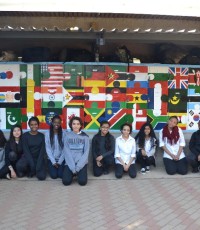
Susan (far right – click the image to see the full photo) with students from her Community Artists service group, which she spearheaded this year at Maru-a-Pula. The group, including about 40 students from all grade levels, conceptualized and painted this mural in order to celebrate the diversity of MaP’s student and staff community. Fitting together as in a jigsaw puzzle, the flags each represent MaP community members who call the respective countries their home.
After accepting a position to teach at Maru-a-Pula School, I was paralyzed by the unknown. The school looked like a dream, but would I find “my place” there in just one year? Admittedly, I knew little about Botswana, much less its capital Gaborone, which would become my home. What would my daily life look like? Would I learn the language? Would I form meaningful relationships? What challenges would I face? These questions were too much to confront. Instead of looking for answers, for better or worse, I simply set expectations aside, accepting that I’d figure things out along the way.
“Expectation” has proved a meaningful teacher. Was I right to avoid setting expectations? In some instances, surely not. I found myself reciting a familiar phrase in my head as the doubts rolled in. I’m having some difficulty in my classroom. What did I expect? I’m struggling to understand cultural norms. What did I expect? I’m homesick. Well… what did I expect?
Although I could’ve predicted some challenges I’d face, and perhaps prepared myself more thoroughly, withholding expectations before my fellowship experience has also opened incredible doors. I couldn’t have known to expect the most valuable aspects of my year teaching in Botswana.
Although I predicted that I’d be a learner as well as a teacher in my history classroom, I never guessed I’d discover so much from my students. Whether age 12 or 18, they each teach me about empathy, gratitude, and embracing each moment for the teacher that it is. I’m grateful that they share their stories with me and for every side conversation that perhaps distracts from our subject, whether it’s a quick tutorial on how to “Dab,” or a mini-lesson in Setswana. They are giving, brave, and gracious, and they make me into a better teacher and human each day.
Many other aspects of life at MaP were happy surprises. I didn’t expect that as Boarding House assistant, I’d so enjoy hanging out on campus with students, talking about growing up, aspirations for the future, or how we wished the caf were serving ribs. Similarly, I found an outlet to engage with students outside the classroom within the school’s co-curricular program, through which I have led several activities including a children’s home volunteer group and a course in ceramics. Thanks to the freedom of the working environment at MaP, I created a new service group, MaP Community Artists, which completed a campus mural that students conceived of to uplift their campus. These artists continue to teach me about courage, determination, cooperation, and inspiration that drives change.
Most significantly, I didn’t expect that when I decided to teach at MaP, I was signing on to be part of an integrated community that never clocks out at 5pm. From welcoming and compassionate coworkers to eager and inspiring students, the MaP family has been the greatest unexpected gift during my experience in Botswana. With one month left of my fellowship, I look forward to soaking up all they teach me daily.
Notes from the Field
Supporter Profile: Daniela Kaisth, Gratias Partners (PiAf Board Member)
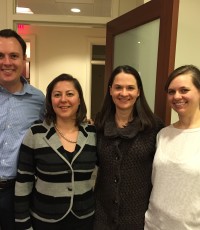
Daniela (second from the left) helping with PiAf Fellow interviews in January 2015. Pictured with Mike Scharff, PiAf 2008-09 Fellow and Advisory Board Member; Katie Henneman, Former PiAf Executive Director; and Liz Braden, PiAf Program Manager.
Daniela Kaisth is President of Gratias Partners, a philanthropy consulting firm focused on starting new foundations and philanthropic entities, encouraging more effective giving through collaboration, and strengthening non-profits and foundations through strategic grant-writing and fund development. She has been an active and enthusiastic PiAf board member since 2012 and currently serves on the program, safety and security, and development committees. Daniela supports PiAf because she believes deeply in the importance of international, service-oriented fellowships to Africa. Through her focus on philanthropy, previous work with the Institute of International Education (IIE), and personal experience with study abroad, Daniela has seen the transformative power of such experiences first-hand.


